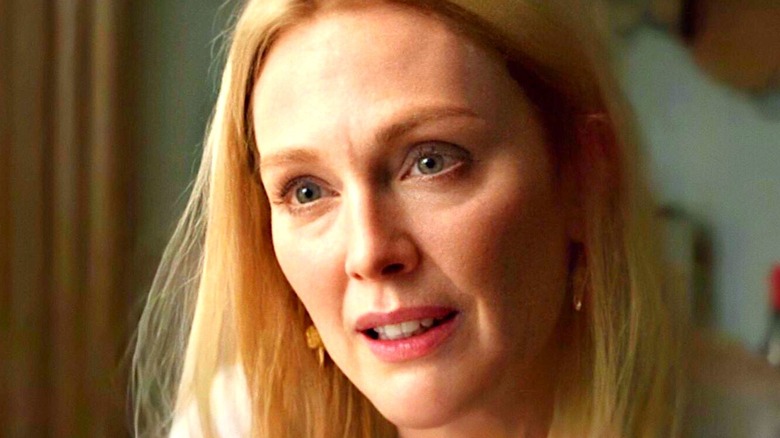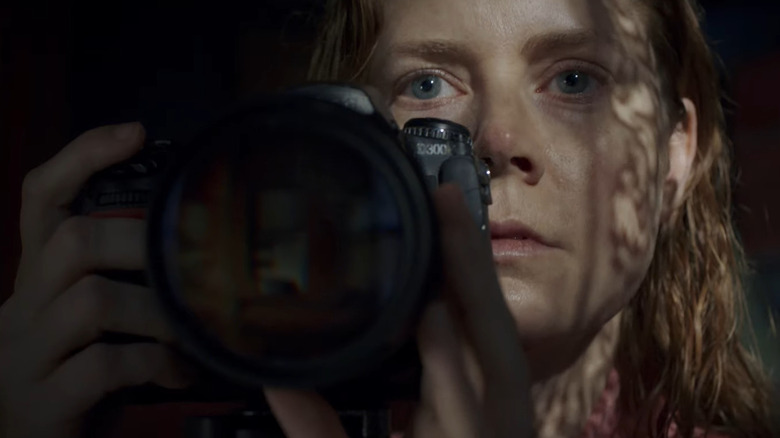What Only Fans Of The Novel Know About The Woman In The Window
Netflix's newest crime thriller has critics and audiences talking, but many fans might not know that it's based on a best-selling novel... and that the story changed quite a bit during its leap from the page to the screen.
Directed by Joe Wright ("Pride & Prejudice," "Anna Karenina") and starring Amy Adams, Gary Oldman, Julianne Moore, Wyatt Russell, Jennifer Jason Leigh, and more, "The Woman in the Window" tells the story of mental health professional and depressive agoraphobe Anna Fox (Adams), who, along with her trusty bottle of wine, simply sits in her New York brownstone and watches the outside world pass her by. However, one night, her world is turned upside down when she sees her neighbor, Alistair Russell (Oldman) stab his wife Jane (Julianne Moore) to death... and the police are understandably baffled by Anna's story, considering that a new Jane (Leigh) has appeared on the scene.
When directors and writers adapt a novel, there's always some changes in the narrative, but "The Woman in the Window" has quite a few, as well as a super-dramatic real-life backstory. Here's what only fans of the novel know about the new Netflix film "The Woman in the Window." Huge spoilers ahead!
There are some vital differences between The Woman and the Window from page to screen
For the most part, the essential twist of "The Woman in the Window” remains more or less the same — which is that Alistair's son Ethan (Fred Hechinger) kills the first Jane. However, his reasons are a bit different; in the novel, Ethan is the adopted son of Alistair and the second Jane, and Moore's Jane is his birth mother, Katie, whom Ethan kills in a fit of rage. Beyond that, he also continues to trick Anna into sympathizing with him even after he confesses to the murder in the novel, whereas in the film, Anna uncovers Ethan's deception — namely, that he has been spying on and gaslighting Anna throughout the story — much more abruptly.
Beyond that, Ethan's role is bafflingly diminished — which isn't the case in the novel — to pave the way for Wyatt Russell's David, Anna's downstairs tenant, to have a much larger role. By putting David at the forefront instead of Ethan (David's role in the novel is quite small), Wright and his creative team definitely give the recent MCU breakout more screen time, but it does come at the cost of the story.
Finally, the other major twist — that Anna's husband Ed (Anthony Mackie) and daughter Olivia, to whom she frequently speaks on the phone, are actually dead — has some small, subtle changes. In both versions, the audience discovers, after several phone conversations, that Ed and Olivia died in a car accident in the aftermath of Anna carrying on an extramarital affair. However, the movie leaves out the seemingly important fact that, after losing her husband and daughter in the crash, Anna is stuck in a snowy, freezing terrain for a few days, which would perfectly explain her agoraphobia.
The story behind the novel's author is crazy and compelling
Just in case "The Woman in the Window" doesn't have enough drama for you, the story behind the novel and its author, A.J. Finn, has plenty. Finn, whose real name is Daniel Mallory, was the subject of a thoroughly researched and utterly shocking exposé by Ian Parker in The New Yorker in 2019, alleging that Mallory — who chose the pen name "A.J. Finn" due to its brevity — had lied extensively about many events in his life, including family tragedies, his degree, and more. Parker compares Mallory to Tom Ripley, the quixotic con man from "The Talented Mr. Ripley," claiming that, throughout his publishing career, the author had constantly misled coworkers and higher-ups, claiming that he and his family members had cancer multiple times, saying he taught at Oxford University and held a degree there (which was never confirmed by Oxford), and told crowds he had worked on book projects with Tina Fey and J.K. Rowling, neither of which turned out to be true. Disturbingly, Mallory even told people his mother and brother had died tragically... though both were very much alive.
Ultimately, the New Yorker profile is an extraordinarily wild ride, and though Mallory eventually admitted he had, well, embellished certain aspects of his life, the stain on his reputation remains. It's rare that the real-life tale behind a mystery novel is just as intense as the fictional story, but clearly, Mallory's story is worth a look alongside "The Woman in the Window."
"The Woman in the Window" is streaming on Netflix now.


